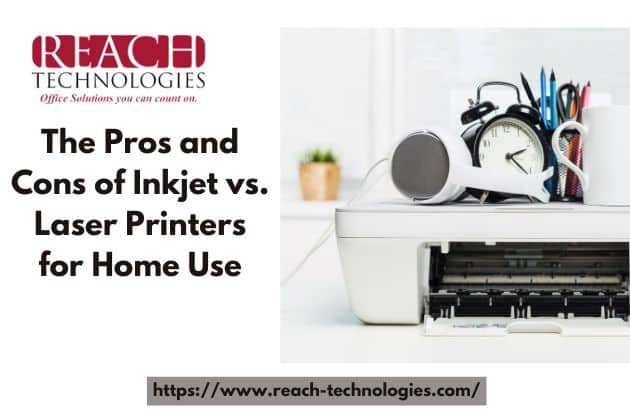
When you’re in the market for printers for home use, you may feel overwhelmed by the two most common options: inkjet and laser printers. Making the right choice can be tough, but fear not! We’ve put together a comprehensive comparison of these two types of printers that highlights their strengths and weaknesses. Read on for a clear and informed decision.
Introduction
Inkjet printers utilize liquid ink for printing text and images onto paper, while laser printers employ toner and heat to produce an image on paper. Despite being widely utilized in homes and offices, both printers offer distinct features, benefits, and limitations.
How Inkjet Printers Work
Inkjet printers operate by spraying countless minuscule droplets of ink onto paper through tiny nozzles. The ink gets swiftly soaked by the paper and dries rapidly. Renowned for their capacity to reproduce high-quality and vivid colors, inkjet printers are a natural choice for those seeking to print photos or artwork. Experience professional-quality prints in the comfort of your own home with an inkjet printer.
How Laser Printers Work
Laser printers are efficient and fast printers that use toner cartridges filled with dry ink particles. Through precision laser beam technology, the toner is heated and fused onto the paper, resulting in long-lasting, high-quality black-and-white text documents.
Pros and Cons of Inkjet Printers
Pros
High-quality color printing: Inkjet printers produce high-quality color images and photos with vibrant colors and sharp details.
Affordable upfront cost: Inkjet printers are generally cheaper than laser printers, making them an ideal choice for budget-conscious consumers.
Small size: Inkjet printers are usually smaller than laser printers, making them easier to fit on a desk or in a small space.
Flexible paper handling: Inkjet printers can handle a wide range of paper types and sizes, including glossy photo paper, cardstock, and labels.
Cons
Expensive ink cartridges: Inkjet printers use expensive ink cartridges that can quickly add up to a significant expense over time.
Slow printing speed: Inkjet printers are slower than laser printers, especially when printing large documents.
Prone to smudging: Inkjet prints can smudge if the ink is not allowed to dry completely before handling.
High cost per page: Inkjet printers have a higher cost per page than laser printers, making them less cost-effective in the long run.
Pros and Cons of Laser Printers
Pros
Fast printing speed: Laser printers are much faster than inkjet printers, especially when printing large documents.
Low cost per page: Laser printers have a lower cost per page than inkjet printers, making them more cost-effective in the long run.
High-quality black and white printing: Laser printers produce high-quality black and white text documents quickly and efficiently.
Long-lasting toner cartridges: Laser printers use toner cartridges that can last for thousands of pages, reducing the need for frequent replacements.
Cons
Expensive upfront cost: Laser printers are generally more expensive than inkjet printers, making them less suitable for consumers on a tight budget.
Limited color printing: Laser printers are not as good at printing high-quality color images and photos as inkjet printers.
Large size: Laser printers are usually larger than inkjet printers, making them less convenient to fit in small spaces.
Limited color printing: Laser printers are not as good at printing high-quality color images and photos as inkjet printers. They are primarily designed for printing black and white text documents.
Large size: Laser printers are usually larger than inkjet printers, making them less convenient to fit in small spaces. They also tend to be heavier, which can make them difficult to move around.
Expensive upfront cost: Laser printers are generally more expensive than inkjet printers, making them less suitable for consumers on a tight budget. They also require additional components such as a fuser, which can add to the cost.
Limited paper handling: Laser printers are not as flexible as inkjet printers when it comes to handling different types of paper. They are generally designed to handle standard letter and legal size paper, and may not be able to handle thicker paper or envelopes.
Which Printers for Home Use is Right for You?
With a plethora of options available, it can be challenging to determine which type is best suited for your needs and personal preferences. Ultimately, your choice will depend on what you require from your printer. In this guide, we’ll explore the differences between inkjet and laser printers, helping you make an informed decision.
Printing needs: Consider what you will be printing the most. If you will be printing primarily black and white text documents, a laser printer might be a good choice. If you need to print color documents or photos, an inkjet printer might be a better fit.
Budget: Laser printers are generally more expensive upfront, but they tend to be more cost-effective over time because they require less frequent cartridge replacements. Inkjet printers are less expensive upfront, but they can be more expensive to maintain over time due to the cost of ink cartridges.
Space: Consider the amount of space you have available for your printer. Laser printers tend to be larger and heavier than inkjet printers, so they may not be suitable for small spaces.
Connectivity: Consider how you will connect your printer to your devices. Many printers now offer wireless connectivity, which can be convenient for printing from multiple devices.
Special features: Some printers offer additional features such as scanning, copying, and faxing. Consider whether you need any of these features in your home printer.
By considering these factors and weighing the pros and cons of each printer type, you can determine which printer is right for you and your home use.
Conclusion
Choosing between inkjet and laser printers for home use can be a difficult decision. However, it ultimately depends on your specific needs and preferences.
If you frequently print high-quality color images and photos, an inkjet printer is the better choice. It offers more flexibility in terms of paper handling and tends to be less expensive upfront. However, keep in mind that ink cartridges can be costly to replace over time.
On the other hand, if you primarily print black-and-white text documents at a high volume, a laser printer is the way to go. Although it may be more expensive upfront, it requires less frequent cartridge replacements and is a more cost-effective option in the long run.
Both inkjet and laser printers have their advantages and disadvantages, so choose the one that best fits your lifestyle.
